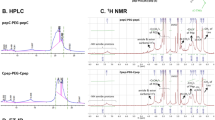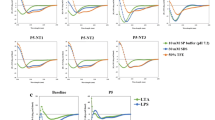Abstract
Antimicrobial peptides are thought to be promising antibiotic substitutes for a variety of multidrug-resistant bacteria. Nevertheless, there are several issues with their clinical and commercial development, such as the high cost of peptide manufacturing and the susceptibility to proteases. Peptide mimics include peptoids have emerged as a promising substitute for antimicrobial peptides, since they are resistant to enzymatic degradation and exhibit significant antibacterial action. In this study we have examined the potential of a newly designed peptoid PPT, which is based on an amphipathic template of the cationic peptide A-12. Using the microbroth dilution method, antimicrobial activity of synthesized compounds was tested on various bacterial strains including a gentamicin- resistant E. coli. Human RBCs and HEK 293 cells were employed for a cytotoxicity study, and SEM was used to see the morphological changes induced by peptidomimetics on E. coli. Further, the checkerboard method aimed to investigate synergy between peptide –antibiotics combination against various bacterial and fungal strains. Results suggested that PPT exhibit significant antimicrobial activity even in the presence of different salts with MICs ranges from 64 to 3.1 µg/ml against tested strains. Based on FIC values, PPT showed additive effect in combination with gentamicin against E. coli and synergistic effect in combination with fluconazole, amphotericin B and tetracycline against A. niger, A. flavus and E. coli. Additionally, PPT showed low toxicity to hRBCs and kidney cell lines. Furthermore, the microscopic examination has shown that peptoid has the potential to damage the cell membranes of E. coli. Overall, the easier synthesis and potent antimicrobial activity makes PPT a suitable candidate for drug development.




Similar content being viewed by others
Data Availability
All data generated or analyzed during this study are included in this published article [and its supplementary information files].
Code Availability
Not applicable.
References
Amblard M, Fehrentz JA, Martinez J, Subra G (2006) Methods and protocols of modern solid phase peptide synthesis. Mol Biotechnol 33:239–254. https://doi.org/10.1385/MB:33:3:239
Antosova Z, Mackova M, Kral V, Macek T (2009) Therapeutic application of peptides and proteins: parenteral forever? Trends Biotechnol 27(11):628–635. https://doi.org/10.1016/j.tibtech.2009.07.009
Arcidiacono S, Soares JW, Meehan AM, Marek P, Kirby R (2009) Membrane permeability and antimicrobial kinetics of cecropin P1 against Escherichia coli. J Pep Sci 15(6):398–403. https://doi.org/10.1002/psc.1125
Bahar AA, Ren D (2013) Antimicrobial Peptides. Pharmaceuticals 6(12):1543–1575. https://doi.org/10.3390/ph6121543
Brogden KA (2005) Antimicrobial peptides: pore formers or metabolic inhibitors in bacteria? Nat Rev Microbiol 3(3):238–250. https://doi.org/10.1038/nrmicro1098
Chen YQ, Min C, Sang M, Han YY, Ma X, Xue XQ, Zhang SQ (2010) A cationic amphiphilic peptide ABP-CM4 exhibits selective cytotoxicity against leukemia cells. Peptides 31(8):1504–1510. https://doi.org/10.1016/j.peptides.2010.05.010
Chongsiriwatana NP, Patch JA, Czyzewski AM, Dohm MT, Ivankin A, Gidalevitz D, Barron AE (2008) Peptoids that mimic the structure, function, and mechanism of helical antimicrobial peptides. Proc Natl Acad Sci 105(8):2794–2799. https://doi.org/10.1073/pnas.0708254105
Chudobova D, Dostalova S, Blazkova I, Michalek P, Ruttkay-Nedecky B, Sklenar M, Nejdl L, Kudr J, Gumulec J, Tmejova K, Konecna M, Vaculovicova M, Hynek D, Masarik M, Kynicky J, Kizek R, Adam V (2014) Effect of ampicillin, streptomycin, penicillin and tetracycline on metal resistant and non-resistant Staphylococcus aureus. Int J Environ Res Public Health 11(3):3233–3255. https://doi.org/10.3390/ijerph110303233
CLSI (2012) Methods for dilution antimicrobial susceptibility tests for bacteria that grow aerobically; Approved Standard—Ninth Edition. CLSI document M07-A9. Clinical and Laboratory Standards Institute, Wayne, PA
da Silva JA, Teschke O (2003) Effects of the antimicrobial peptide PGLa on live Escherichia coli. Biochim Biophys Acta 1643(1–3):95–103. https://doi.org/10.1016/j.bbamcr.2003.10.001
Dewangan RP, Bisht GS, Singh VP, Yar MS, Pasha S (2018) Design and synthesis of cell selective α/β-diastereomeric peptidomimetic with potent in vivo antibacterial activity against methicillin resistant S. aureus. Bioorg Chem 76:538–547. https://doi.org/10.1016/j.bioorg.2017.12.020
Dohm MT, Kapoor R, Barron AE (2011) Peptoids: bio-inspired polymers as potential pharmaceuticals. Curr Pharm Des 17(25):2732–2747. https://doi.org/10.2174/138161211797416066
Duong L, Gross SP, Siryaporn A (2021) Developing antimicrobial synergy with AMPs. Front Med Technol 3:640981. https://doi.org/10.3389/fmedt.2021.640981
Erdem Buyukkiraz M, Kesmen Z (2022) Antimicrobial peptides (AMPs): a promising class of antimicrobial compounds. J Appl Microbiol 132(3):1573–1596. https://doi.org/10.1111/jam.15314
Feng Q, Huang Y, Chen M, Li G, Chen Y (2015) Functional synergy of α-helical antimicrobial peptides and traditional antibiotics against Gram-negative and gram-positive bacteria in vitro and in vivo. Eur J Clin Microbiol Infect Dis 34:197–204. https://doi.org/10.1007/s10096-014-2219-3
Gopal R, Kim YG, Lee JH, Lee SK, Chae JD, Son BK, Park Y (2014) Synergistic effects and antibiofilm properties of chimeric peptides against multidrug-resistant Acinetobacter baumannii strains. Antimicrob Agents Chemother 58(3):1622–1629. https://doi.org/10.1128/AAC.02473-13
Hale JD, Hancock RE (2007) Alternative mechanisms of action of cationic antimicrobial peptides on bacteria. Expert Rev Anti-Infect Ther 5(6):951–959. https://doi.org/10.1586/14787210.5.6.951
Jahangiri A, Neshani A, Mirhosseini SA, Ghazvini K, Zare H, Sedighian H (2021) Synergistic effect of two antimicrobial peptides, Nisin and P10 with conventional antibiotics against extensively drug-resistant Acinetobacter baumannii and colistin-resistant Pseudomonas aeruginosa isolates. Microb Pathog 150:104700. https://doi.org/10.1016/j.micpath.2020.104700
Kang HK, Kim C, Seo CH, Park Y (2017) The therapeutic applications of antimicrobial peptides (AMPs): a patent review. J Microbiol 55(1):1–12. https://doi.org/10.1007/s12275-017-6452-1
Khara JS, Mojsoska B, Mukherjee D, Langford PR, Robertson BD, Jenssen H, Newton SM (2020) Ultra-short antimicrobial peptoids show propensity for membrane activity against multi-drug resistant mycobacterium tuberculosis. Front Microbiol 11:417. https://doi.org/10.3389/fmicb.2020.00417
Lee J, Kang D, Choi J, Huang W, Wadman M, Barron AE, Seo J (2018) Effect of side chain hydrophobicity and cationic charge on antimicrobial activity and cytotoxicity of helical peptoids. Bioorg Med Chem Lett 28(2):170–173. https://doi.org/10.1016/j.bmcl.2017.11.034
Li RK, Rinaldi MG (1999) In vitro antifungal activity of nikkomycin Z in combination with fluconazole or itraconazole. Antimicrob Agents Chemother 43(6):1401–1405. https://doi.org/10.1128/AAC.43.6.140
Malanovic N, Lohner K (2016) Antimicrobial peptides targeting gram-positive bacteria. Pharmaceuticals 9(3):59. https://doi.org/10.3390/ph9030059
Marcos JF, Gandia M (2009) Antimicrobial peptides: to membranes and beyond. Expert Opin Drug Discov 4(6):659–671. https://doi.org/10.1517/17460440902992888
Matsuzaki K (1999) Why and how are peptide–lipid interactions utilized for self-defense? Magainins and tachyplesins as archetypes. Biochim Biophys Acta (BBA)-Biomembr 1462(1–2):1–10. https://doi.org/10.1016/S0005-2736(99)00197-2
Matsuzaki K (2009) Control of cell selectivity of antimicrobial peptides. Biochim Biophys Acta (BBA)-Biomembr 1788(8):1687–1692. https://doi.org/10.1016/j.bbamem.2008.09.013
Mojsoska B, Zuckermann RN, Jenssen H (2015) Structure-activity relationship study of novel peptoids that mimic the structure of antimicrobial peptides. Antimicrob Agents Chemother 59(7):4112–4120. https://doi.org/10.1128/AAC.00237
Mojsoska B, Carretero G, Larsen S, Mateiu RV, Jenssen H (2017) Peptoids successfully inhibit the growth of Gram- negative E. coli causing substantial membrane damage. Sci Rep 7(1):1–12. https://doi.org/10.1038/srep42332
Morici P, Florio W, Rizzato C, Ghelardi E, Tavanti A, Rossolini GM, Lupetti A (2017) Synergistic activity of synthetic N-terminal peptide of human lactoferrin in combination with various antibiotics against carbapenem-resistant Klebsiella pneumoniae strains. Eur J Clin Microbiol Infect Dis 36(10):1739–1748. https://doi.org/10.1007/s10096-017-2987-7
Ning Y, Yan A, Yang K, Wang Z, Li X, Jia Y (2017) Antibacterial activity of phenyllactic acid against Listeria monocytogenes and Escherichia coli by dual mechanisms. Food Chem 228:533–540. https://doi.org/10.1016/j.foodchem.2017.01.112
Patch JA, Barron AE (2002) Mimicry of bioactive peptides via non-natural, sequence-specific peptidomimetic oligomers. Curr Opin Chem Biol 6(6):872–877. https://doi.org/10.1016/S1367-5931(02)00385-X
Peterson E, Kaur P (2018) Antibiotic resistance mechanisms in bacteria: relationships between resistance determinants of antibiotic producers, environmental bacteria, and clinical pathogens. Front Microbiol 9:2928. https://doi.org/10.3389/fmicb.2018.02928
Pletzer D, Mansour SC, Hancock RE (2018) Synergy between conventional antibiotics and anti-biofilm peptides in a murine, sub-cutaneous abscess model caused by recalcitrant ESKAPE pathogens. PloS Pathog 14(6):e1007084. https://doi.org/10.1371/journal.ppat.1007084
Pontes JTCD, Toledo Borges AB, Roque-Borda CA, Pavan FR (2022) Antimicrobial peptides as an alternative for the eradication of bacterial biofilms of multi-drug resistant bacteria. Pharmaceuticals 14(3):642. https://doi.org/10.3390/pharmaceutics14030642
Quah Y, Mohd Ismail NI, Ooi JL, Affendi YA, Abd Manan F, Wong FC, Chai TT (2018) Identification of novel cytotoxic peptide KENPVLSLVNGMF from marine sponge Xestospongia testudinaria, with characterization of stability in human serum. Int J Pep Res Ther 24:189–199. https://doi.org/10.1007/s10989-017-9604-6
Reference method for broth dilution antifungal susceptibility testing of filamentous fungi; Approved Standard (2002) NCCLS document M38-A. ISBN 1–56238–470–8
Rosenfeld Y, Lev N, Shai Y (2010) Effect of the hydrophobicity to net positive charge ratio on antibacterial and anti-endotoxin activities of structurally similar antimicrobial peptides. Biochem 49(5):853–61. https://doi.org/10.1021/bi900724x
Rotem S, Mor A (2009) Antimicrobial peptide mimics for improved therapeutic properties. Biochim Biophys Acta (BBA)-Biomembr 1788:1582–1592. https://doi.org/10.1016/j.bbamem.2008.10.020
Saini A, Verma G (2017) Peptoids: tomorrow’s therapeutics, 1st edn. Elsevier, The Netherlands, pp 251–280
Sharma D, Choudhary M, Vashistt J, Shrivastava R, Bisht GS (2019) Cationic antimicrobial peptide and its poly-N-substituted glycine congener: antibacterial and antibiofilm potential against A. baumannii. Biochem Biophys Res Commun 518(3):472–478. https://doi.org/10.1016/j.bbrc.2019.08.062
Sharma D, Shrivastava R, Bisht GS (2020) In vitro efficacy of lipid conjugated peptidomimetics against Mycobacterium smegmatis. Int J Pept Res Ther 26(1):531–537. https://doi.org/10.1007/s10989-019-09859-7
Sun Y, Shang D (2015) Inhibitory effects of antimicrobial peptides on lipopolysaccharide-induced inflammation. Mediators Inflamm 2015:1–8. https://doi.org/10.1155/2015/167572
Suwal S, Kodadek T (2013) Synthesis of libraries of peptidomimetic compounds containing a 2-oxopiperazine unit in the main chain. Org Biomol Chem 11(13):2088–2092. https://doi.org/10.1039/c3ob27476d
Takahashi D, Shukla SK, Prakash O, Zhang G (2010) Structural determinants of host defense peptides for antimicrobial activity and target cell selectivity. Biochimie 92(9):1236–1241. https://doi.org/10.1016/j.biochi.2010.02.023
Tran H, Gael SL, Connolly MD, Zuckermann RN (2011) Solid-phase submonomer synthesis of peptoid polymers and their self-assembly into highly-ordered nanosheets. J Vis Exp 57:e3373. https://doi.org/10.3791/3373
Ulvatne H, Vorland LH (2001) Bactericidal kinetics of 3 lactoferricins against Staphylococcus aureus and Escherichia coli. Scand J Infect Dis 33(7):507–511. https://doi.org/10.1080/00365540110026692
Vega C, Perez-Perez L, Arguello H, Gomez-Garcia M, Puente H, Fernandez-Uson I, Carvajal A (2022) In vitro evaluation of gentamicin activity against Spanish field isolates of Brachyspira hyodysenteriae. Porcin Health Manag 8(1):48. https://doi.org/10.1186/s40813-022-00291-w
Wu X, Li Z, Li X, Tian Y, Fan Y, Yu C, Zhou B, Liu Y, Xiang R, Yang L (2017) Synergistic effects of antimicrobial peptide DP7 combined with antibiotics against multidrug-resistant bacteria. Drug Des Devel Ther 11:939–946. https://doi.org/10.2147/DDDT.S107195
Yuan Z, Aweya JJ, Li J, Wang Z, Huang S, Zheng M, Yang S (2022) Synergistic antibacterial effects of low-intensity ultrasound and peptide LCMHC against Staphylococcus aureus. Int J Food Microbiol 373:109713. https://doi.org/10.1016/j.ijfoodmicro.2022.109713
Zhang C, Yang M (2022) Antimicrobial peptides: from design to clinical application. Antibiot 11(3):349. https://doi.org/10.3390/antibiotics11030349
Acknowledgements
We would like to acknowledge JUIT, Solan for providing research facilities. We would also thank to Dr. Jata Shankar, Biotechnology department JUIT and ASBASJS Memorial College of Pharmacy, Punjab for their support in our study of fungal strains and drug resistant strain respectively.
Funding
This study was supported by the Indian Council of Medical Research (ICMR), Delhi, (Grant Number; 52/4/2013- Bio BMS).
Author information
Authors and Affiliations
Contributions
All authors contributed to the study conceptions and designs. Material preparations, data collection, and manuscript were written by LS. Dr. GSB read, analyze and approved the final manuscript for publication.
Corresponding author
Ethics declarations
Conflict of interest
No conflict of interest to disclose.
Ethical Approval
The present study was approved by Institutional Ethics Committee (IEC/Project No-02/2023).
Consent to Participate
Not required.
Consent to Publish
Not required.
Additional information
Publisher's Note
Springer Nature remains neutral with regard to jurisdictional claims in published maps and institutional affiliations.
Supplementary Information
Below is the link to the electronic supplementary material.
Rights and permissions
Springer Nature or its licensor (e.g. a society or other partner) holds exclusive rights to this article under a publishing agreement with the author(s) or other rightsholder(s); author self-archiving of the accepted manuscript version of this article is solely governed by the terms of such publishing agreement and applicable law.
About this article
Cite this article
Sharma, L., Bisht, G.S. In Vitro Biological Evaluation and Mechanism of Action of Peptoid Analogue Based on Cationic, Amphipathic Peptide A-12. Int J Pept Res Ther 29, 98 (2023). https://doi.org/10.1007/s10989-023-10566-7
Accepted:
Published:
DOI: https://doi.org/10.1007/s10989-023-10566-7




